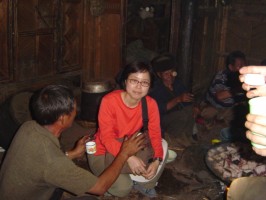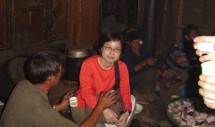I will say medical anthropology stands out in our contemporary world because it is a sub-field of anthropology that combines knowledge and concerns of natural sciences, social sciences and humanities as well as crisscrosses the boundary of history and culture. It confronts the personal well-being of individual human beings, as well as the universal meanings of humanity. Both social relevance and academic reflexivity are at the core of medical anthropology. I myself find the knowledge and concern of medical anthropology help me both pursue a critical academic career and an engaging life beyond the ivory tower. RK: Congratulations on the Junior Researcher Award from your Institute. What contribution does this award recognize?
SHL: This Junior Research Investigators Award is sponsored by Academia Sinica starting in 1996 and is meant to enhance the research potential of young scholars in both Academia Sinica and other research institutions in Taiwan. Application is open to scholars throughout Taiwan in three academic divisions (life sciences, physics and mathematics, and humanity and social sciences) and under the age of 42. Each year at most five scholars from each field are selected to be recipients of this most prestigious award for junior scholars. This award emphasizes the significance of research publication. Each applicant can submit 1-3 representative works for a rigorous review process.
RK: What does your work involve in the Institute of Ethnology, Academia Sinica?
SHL: Academia Sinica is a pure research institute sponsored by the Taiwanese government and my major work in its Institute of Ethnology is to do research based on topics of my own choice and to publish scholarly works within and beyond Taiwan. Besides research, Academia Sinica faculty members are allowed to teach maximally 4 credits of course per semester, depending on a university’s invitation and the researcher’s willingness to teach. As for myself, I teach one course a year mainly in two universities: the National Taiwan University and Soochow University.
My research lies mainly in the field of medical anthropology, in relation to globalization, modernity and gender, and with a regional focus on China. My medical anthropological research uses diseases such as AIDS, drug use, or leprosy as the vantage point to analyze the nature and trajectories of contemporary social change in China, as well as individuals’ life experiences and transformations within social change. In addition, I also examine the development of public health in China to understand the roles external forces such as the state and the global market played in shaping social change. Starting in 2012, I will also launch a new project on community health and resilience among Taiwanese indigenous peoples in the shadows of social and natural calamities.
Academia Sinica is the leading academic institution in Taiwan, and many academic societies or associations are sponsored by its discipline-based institutes. For instance, since 2007, Taiwan Society for Anthropology and Ethnology (TSAE) has been housed in the Institute of Ethnology (IOE). TSAE’s current president is also the director of my institute (IOE), Prof. Shu-min Huang, and I have been serving as the secretary for TSAE since 2007, the year my employment at IOE began. TSAE has launched a grand annual meeting for members, similar to the AAA yet in a much smaller scale. In 2009, TSAE also collaborated with Society for East Asian Anthropology of American Anthropological Association and hosted a joint annual meeting. This specific meeting attracted over 400 participants, including 200-some scholars from abroad. In addition, I also served as the secretary to host the 2nd preparatory meeting for the founding of a regional society for anthropology in East Asia, including China, Hong Kong, Japan, South Korea, and Taiwan.
RK:Can you tell us about your introduction to the Chinese translation of Ruth Behar’s Vulnerable Observer? Why was this particular book translated?
SHL: My introduction to Ruth Behar’s work is to position her significance, topic and writing style within the development of anthropology since the 1980s. In essence, I focus on the significance of gender, emotion and reflection upon human suffering conveyed in this book in order to inspire readers, both with or without anthropological background. Although this book was published in English over ten years ago, there have not been that many anthropological books of this kind published in Taiwan. This book was chosen for translation in Taiwan because of the wise decision of its translator and editor (Mr. En-lin Huang) who was trained in anthropology in Taiwan.
RK: Are you planning a Chinese translation of your recent book, Passage to Manhood ?
SHL: Yes. I feel obliged to have it published in Chinese too for the convenience of local people who helped me complete this research and who are concerned about their society. Some publishing houses in Taiwan and China have urged me to do so. I have decided to work on the Chinese version on my own, namely, not to have it translated by someone else. I feel that it’s more appropriate for me to write it in my mother tongue. I expect to finish the rewriting project in a year.
RK: How is the anthropology curriculum organized in your institute?
SHL: As I said earlier, my institute is purely research-based. So there is no anthropology curriculum in my institute. But we do organize an AnthroCamp every year which usually provides 3-4 day training workshop for senior undergraduates and graduates. As for the annual theme of workshop, it depends on the responsible organizers’ arrangement. In 2008, I was assigned to organize a special AnthroCamp which focused on writing enhancement for junior scholars (below the assistant professor level) and advance doctoral students enrolled in related programs of anthropology in Taiwan. In this special workshop, we invited editors-in-chief of five well-known anthropology journals in the US and UK (e.g., American Anthropologist, Journal of Royal Anthropological Institute, Human Organization, Medical Anthropology Quarterly, etc.). In total, these senior editors commented on participants’ working papers or grant proposals, all in English, one on one.
As for my own teaching courses, I have taught three subjects: “Anthropology of Social Suffering,” “Medical Anthropology,” and “Altruism: Perspectives of Medical Anthropology.”
RK: When I contacted you, you were conducting fieldwork in a leprosy village. Is this a new project? What is a leprosy village?
SHL: During my previous research on heroin use and HIV/AIDS in Southwest China (2002-2009; my new book Passage to Manhood was the completion of this previous research), I have also collected data on leprosy control in the same region. Upon my employment in my current institute, I began a new project on leprosy in China. So far, counting by funding supports, I have conducted research on leprosy in China for nearly four years. I plan to complete my fieldwork in two years and will begin to write about my findings by the end of this year.
Leprosy villages are where cured or present lepers stay, in some cases even with their healthy family members. The People’s Republic of China began its massive campaigns on leprosy control starting in the late 1950s. Confirmed lepers (leprosy is a term used in China; the other term, Hansen’s disease that is commonly used elsewhere, is not adopted in China) were confined for treatment or simply quarantined in the so-call leprosaria. Some leprosaria are hospital-based; many other are just like secluded villages. Local health workers or residents simply call them “leprosy villages.”
RK: What exciting directions and questions are animating medical anthropology today?
SHL: I will say medical anthropology stands out in our contemporary world because it is a sub-field of anthropology that combines knowledge and concerns of natural sciences, social sciences and humanities as well as crisscrosses the boundary of history and culture. It confronts the personal well-being of individual human beings, as well as the universal meanings of humanity. Both social relevance and academic reflexivity are at the core of medical anthropology. I myself find the knowledge and concern of medical anthropology help me both pursue a critical academic career and an engaging life beyond the ivory tower. Critical and reflexive thinking of the ethics, tension, approaches, possibilities and limits that a medical anthropologist may face in researching life, death, disease, health and well-being of people in every walk of life is a never-ended and challenging ethical/moral task. I appreciate the value of medical anthropology very much. Currently, medical anthropology is rather under-developed in Taiwan and I hope to promote this field here. So I have organized the first medical anthropology workshop in Taiwan and invited over twenty scholars who have used medical anthropological approaches to present and discuss papers. I will help establish and operate a research group under the theme of medical anthropology in my institute soon in order to continue the endeavors of expanding this field.
RK: The World Council of Anthropological Association supports a Publication Initiative and has a web forum for international journals and translations. Are there connections with anthropology publication in Taiwan?
SHL: In Taiwan, we also have the Taiwan Social Science Citation Index (TSSCI) database which is the equivalent to SSCI. It collects and evaluates many quality journals of social sciences published here. In general, scholarship in Taiwan has been globalizing well and such internationalization drive will continue to extend and expand. For example, Taiwan Society for Anthropology and Ethnology has recently become a member of WCAA. It will be a big push for us if the major anthropology journal, Taiwan Journal of Anthropology, which is sponsored by my institute and which publishes both Chinese and English articles and book review, can be included in the WCAA publication initiative.
Ritu Gairola Khanduri is an assistant professor of cultural anthropology at the University of Texas at Arlington. She read history at the Jawaharlal Nehru University and anthropology at the University of Texas-Austin. Her research foci include media, history, science in colonial and contemporary India. She has also written on and continues to explore Hindu images in the diaspora and Gandhi. Ritu’s book manuscript is an ethnography of newspaper cartooning in India.



One Trackback
[...] News « Change and Evolution An Interview with Medical Anthropologist Shau-hua Liu » Ritu Gairola Khanduri 0 [...]